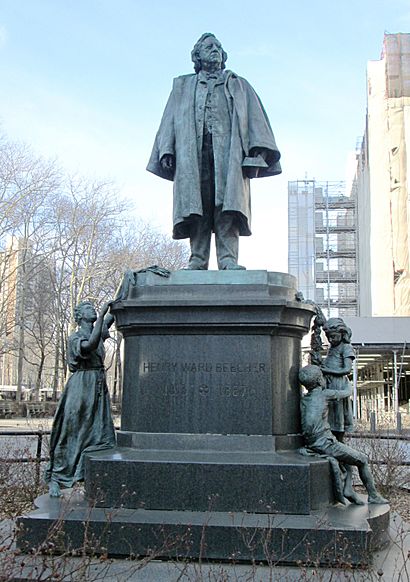Henry Ward Beecher Monument facts for kids
Quick facts for kids Statue of Henry Ward Beecher |
|
|---|---|
 |
|
| Year | 1890 |
| Medium |
|
| Subject | Henry Ward Beecher |
| Location | New York City, New York, U.S. |
The Henry Ward Beecher Monument is a famous statue. It shows Henry Ward Beecher. The artist was John Quincy Adams Ward. It was first shown on June 24, 1891. It was in Borough Hall Park, Brooklyn. Later, in 1959, it moved to Cadman Plaza, Brooklyn.
Contents
About Henry Ward Beecher
Henry Ward Beecher was an important person in the 1800s. He was a liberal preacher and speaker. He believed in freedom for all people. He was a strong voice in the abolitionist movement. This movement worked to end slavery in the United States.
How the Statue Was Made
The sculptor John Quincy Adams Ward was chosen to create the monument. This happened on April 6, 1888. Ward used a special mold of Beecher's face. This mold is called a death mask. He also used photographs to make the statue look just like Beecher. The statue was planned to be eight feet tall.
What the Statue Means
The monument has figures of children at its base. These figures show Beecher's role in the abolitionist movement. They also show his love for children. Many people thought the statue was one of the best public monuments. Some of Beecher's family and friends felt it did not look exactly like him.
What the Statue Looks Like
The monument is made of bronze and granite. The bronze parts were sculpted by John Quincy Adams Ward. The granite base was designed by architect Richard Morris Hunt.
Figures on the Monument
The statue shows Beecher himself. Below him are other figures. To the left of the base, there is a Black female figure. To the right, there are two white children, a boy and a girl. These figures help tell the story of Beecher's work.
When It Was Completed
The bronze parts of the monument were cast on May 10, 1890. The whole monument was officially dedicated on June 24, 1891. In 1987, the statue was cleaned and repaired. This was part of a program to take care of public monuments.

